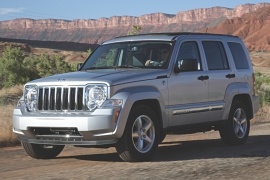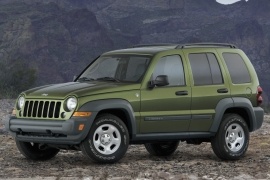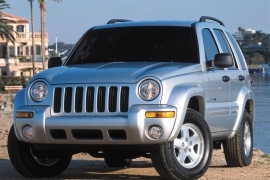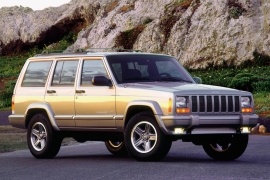JEEP Cherokee/Liberty Models/Series Timeline, Specifications & Photos
First production year: 1984
Engines: Diesel, Gasoline
Body style: SUV (Sports Utility Vehicle)
After its divorce from Daimler, the American automaker Chrysler introduced the second generation of the Liberty mid-size SUV, and the changes were massive.
Financially, Chrysler Group was in deep trouble despite the capital infusion by Cerberus Capital Management, but it tried to survive and thrive by using the same platforms for different brands and models. The second generation of the Liberty was one of the recipients of such technology, sharing its underpinnings with the Dodge Nitro, albeit it was available as a more capable off-road vehicle than the one from its cousin. However, financial troubles were reflected in the price of the car. The base version had a 30% higher price than the 2001 Jeep Liberty. That couldn’t make customers happy, and that was reflected by slow sales. During its seven-year production time, it barely passed the 400,000 units mark. However, it is worth considering that the mid-size SUV also faced the effects of the financial crisis from 2008-2012. Jeep tried and managed to create a desirable vehicle for those who wanted an SUV capable enough to tow a 5,000 lbs (2,268 kg) trailer behind, be comfortable on the road, and still climb some trails. After all, it was trail-rated by Jeep.
One of the most significant upgrades was noticed at the car’s front, where the former round headlights were replaced by angular-shaped ones, which also integrated the fog lamps. The front fascia also resembled the one placed by Jeep on the Commander lineup. The turn signal lamps flanked the headlights, mounted above the bumper, in a horizontal position, similar to those from Liberty’s first generation, the KJ.
Even though it kept the angular styling of its predecessor, the 2005 Liberty KK had a longer wheelbase and overall length than the Liberty KJ. It sported trapezoidal-shaped wheel arches adorned with plastic claddings to make the SUV look more muscular. The chunky grab handles for the doors still had the big opening buttons that could be used with gloves. Depending on the grade, Jeep offered the vehicle with black or body-colored rubber side stripes, which were effective against shopping carts. But there were a couple of firsts for the 2005 Jeep Liberty. One was its tailgate that opened upwards and featured an independent opening system for the rear window, while another was the optional sky-slider canvas roof that could open for more fresh air into the cabin.
Inside, customers enjoyed a pair of bucket seats at the front and a split-folding (60/40) bench seat in the back. Thanks to the longer wheelbase, there was more legroom for the rear-seated passengers. Up front, the two-tone dashboard and the upscale-looking design made the owners happy. On the center stack, the automaker installed an infotainment unit with a touchscreen, DVD player, and sat-nav system with real-time traffic control. Between the front occupants, the automaker placed a center console that housed the gear selector, the handbrake, and a tall armrest with a storage area underneath.
Under the hood, Jeep installed a standard 3.7-liter single-cam V6 engine for the U.S. market, while in other countries, it sold it with a 2.8-liter CRD powerplant. In addition to the six-speed manual, the 2005 Liberty was also available with a four-speed automatic transmission for the gas-powered version or a five-speed automatic for the turbodiesel. A two-speed transfer box was available.
Chrysler introduced a refreshed version of the Liberty lineup for the North American market in the spring of 2004 for the 2005 model year and came with significant upgrades.
With sales that didn’t reach the 200,000 units, the 2001 Liberty was not the sales-winner DaimlerChrysler hoped. As a result, the car got a refresh with upgrades in all areas. Perhaps the least important ones were on the outside, where the automaker just mildly updated the vehicle and fixed some of the mistakes made on the original version. But that wasn’t all. The automaker focused on increasing comfort and amenities and providing the car with a fuel-efficient turbodiesel engine. Unfortunately, that powerplant was unavailable in several states due to stricter emission regulations. Still, otherwise, it was well-received by customers, who bought this oil-burning variant in more than 10,000 units in the first manufacturing year. Unfortunately, that version didn’t last too long because, starting in 2007, rules about emissions changed again, and Jeep had to pull the plug on it.
If there was one thing that Jeep had to upgrade, and customers could notice it instantly, then that was the front fascia. There, the automaker removed the fog lamps from the bumper, which was not a bright idea from the start, considering that the Liberty was marketed as an off-road vehicle. Furthermore, the turn signals were relocated higher, above the bumper. As a result, the SUV was safer while crossing rivers or difficult off-road obstacles. The main grille, with its seven vertical bars, was available either in body color or with a chromed finish, depending on the grade.
The profile wasn’t upgraded too much, albeit several details were changed. For instance, the car had new alloy wheels. All grades featured body-colored wheel-fender claddings. At the same time, the rubber stripe decorations that crossed the door panels were either black or sported the same shade as the rest of the vehicle, depending on the grade. Jeep made the 2005 Liberty available in three grades: Sport, Renegade, and Limited. Regardless of the trim level, all of them featured the spare wheel mounted at the back, on the tailgate, with or without a hard-case cover.
Inside, there were significant upgrades for the 2005 Jeep Liberty. The driver faced a steering wheel with several buttons controlling the stereo and the cruise control functions. The automaker installed large dials inside the instrument cluster for the speedometer and tachometer flanked by the fuel level and the coolant thermometer gauges. All of them sported chromed encirclings for a poshier look. A six-way adjustable driver seat and leather upholstery were also available. Furthermore, on the center stack, the automaker installed a GPS navigation system with a color screen, while the center console housed the gear stick and the handbrake.
Under the hood, the most significant upgrade was the introduction of the 2.8-liter CRD turbodiesel engine developed by VM Motori in Italy. It provided more torque than the V6 gasoline powerplant available for the Liberty but with less power than that. This version was sold for the 2005 and 2006 model years and was canceled afterward. All these upgrades helped the Liberty boost its sales, but not significantly.
Jeep decided to retire the Cherokee XJ in 2001, after successfully sold it for 17 years, with only one significant update in 1997, and the replacement tried to match its predecessor fame, but it couldn't.
Some cars became automotive icons and were difficult to replace. Some automakers managed to do that successfully, while others failed. There is a long list of examples, and the 2001 Jeep Cherokee/Liberty KJ is one of them. Chrysler needed to replace the 17-year-old Cherokee XJ and bring it to modern standards. While customers still loved it, it was no longer a modern vehicle, even though it started as a revolutionary one in 1984. Furthermore, design trends changed, and many buyers were looking for rounded shapes instead of the angular ones typical for vehicles designed in the early '80s. On top of that, the XJ interior was nearly impossible to upgrade to modern standards, especially since the cabin was small.
Jeep noticed that the car couldn't step into forefather's shoes. As a result, for the U.S. market, it sold it under the Liberty name, while the rest of the world got it as the Cherokee. The SUV's front fascia no longer sported rectangular headlights but round, like those mounted on the Wrangler. Between them, the automaker placed the already famous seven-slat grille, which was unique to the Jeep brand. However, the lower bumper was now softer, made from plastic, and integrated the blinkers on the corners.
From its profile, the car's shape still resembled the XJ, but its rounded panels and the taller greenhouse were specific for the KJ. Its flared wheel arches fitted with plastic claddings continued on the doors, trying to create a more aggressive look for the vehicle. But still, it was far from being considered a trustworthy off-road vehicle by its owners. Fortunately, the chunky door handles that were easy to operate while wearing working gloves were still there. Another improvement was found at the back of the car, where the automaker installed a spare wheel on a cradle instead of placing it inside the trunk and diminishing the luggage space.
The interior, on the other hand, was miles away from the 1997 Cherokee XJ, and in a good way. Firstly, the instrument cluster was no longer cluttered by six dials and gauges. It showed just four instead: the speedometer, the tachometer, the fuel level, and the coolant temperature gauges. The driver fronted a redesigned steering wheel with buttons that controlled the media and the cruise control. On the center stack, Jeep installed an integrated stereo with a CD player, while below it was the panel for the HVAC system. Between the front bucket seats, the automaker installed a center console that housed the gear selector, a pair of cup holders, and an armrest with a cubby storage underneath. In the back, the automaker added a split-folding bench seat that could expand the trunk space.
Under the hood, Chrysler installed different engines, depending on the market. Besides the gas-powered versions, the automaker also installed a 2.5-liter VM Motori turbodiesel engine, which was offered for a couple of years in selected U.S. states, not just Europe. Customers could get the Liberty/Cherokee with either a simpler Command-Trac part-time 4WD system or with the Selec-Trac version that added a center differential between the axles, making the vehicle more capable and safe to drive while it was driven on snow-covered surfaces.
After Renault’s departure from the American market, Chrysler took over the remaining of the American Motor Corporation and launched a facelifted version of the already known Cherokee XJ.
Renault ended its alliance with the American Motors Corporation in 1987 after it sold it to Chrysler and then left the U.S. market. However, one of the most significant models developed with the funding and technology of the European automaker remained: the Jeep Cherokee. That model sold well, and Chrysler wanted the brand and finally got it. Fast forward to 1997, and the famous XJ was dramatically enhanced, following some styling cues inspired by its bigger brother, the Grand Cherokee, which Chrysler launched in 1993.
Up front, the car retained the main design elements that made the first generation of the Cherokee a darling for everyone. Its flat, seven-slat grille was reshaped and integrated the rectangular headlights. Underneath these, the automaker placed horizontal blinkers while a new bumper completed the image. Customers could have that in body color, and, at first sight, it looked like it was made from plastic, but it was made from steel.
From its profile, the compact crossover that revolutionized the automotive market still had flat surfaces and windows but shaved corners to look more rounded. Furthermore, Jeep added plastic moldings on the door panels. At the same time, the plastic moldings around the wheel arches were neatly continued by the bumpers. As a result, the car had a composed overall styling. Chrysler considered that the oversized door handles should be kept since they were easy to operate while wearing gloves. The design changes also affected the vehicles sold overseas, in Europe, by Renault. Finally, at the back, the wide tailgate was kept and was flanked by redesigned taillights.
Inside, the utilitarian look of the 1984 Cherokee was replaced by a much more modern one. The dashboard was redesigned, integrating the instrument cluster and the center stack into one big component. Furthermore, the automaker installed dual airbags in the SUV, improving safety. Customers could find comfortable bucket seats available with cloth or artificial leather up front, depending on the grade. In the back, the flat folding bench seat could expand the trunk’s space if needed. The trunk wasn’t that spacious, especially since it also housed the spare wheel mounted on the driver’s side.
However, some of the most significant upgrades to the vehicle happened under its skin. For the U.S. market, Jeep ditched the 2.5-liter engine inherited from AMC, and also dropped the option for the 2.8-liter V6 provided by Chrysler. It kept the four-liter inline-six (written as 4.0 Litre on the car’s back), which was significantly improved over its predecessor and had lower noise and vibration levels. Besides the five-speed manual, the automaker offered the Cherokee with a four-speed automatic as well. Moreover, it ditched the former four-banger engine completely from the model and improved the inline-six it already had. For selected markets, the automaker also offered the Cherokee XJ with either a 2.5-liter inline-four or a 2.1-liter turbodiesel that was later replaced by a 2.5-liter oil burner.
The 1984 Jeep Cherokee XJ was one of those vehicles that redefined the automotive industry in the ‘80s when it became the first unibody crossover vehicle in the world.
American Motors Corporation was in a problematic financial shape in the late ‘70s after the U.S. Congress adopted the Energy Policy and Conservation Act in 1975, which forced automakers to make more fuel-efficient cars. SUVs, at that time, were mostly body-on-frame vehicles powered by V8 engines that drank fuel by the gallon. AMC tried to survive with its small-sized cars, such as the Pacer, which sported a controversial styling that made it hard to sell. Then, in 1979, Renault bought AMC and infused a big chunk of money into the American automaker to bring it back on the profit side. One of the secret weapons to do that was the Jeep Cherokee. A car that was proposed before the acquisition but reached production in 1984. Its compact size, the ability to carry five people on board, and a large trunk in the rear transformed the Cherokee XJ into a sales winner.
The overall design was directly inspired by its older sibling, the Grand Wagooner. It featured the classic seven-slats Jeep grille at the front flanked by rectangular headlights. Lower, the automaker installed a slim bumper protected by rubber blocks and mounted directly onto the car’s frame. Unlike any other SUV, the Cherokee featured a bodywork welded onto the vehicle’s chassis. As a result, it was at least 1,000 lbs (454 kg) lighter than its competitors but also very rugged.
AMC styling team started to pen the vehicle in the mid-70s, but due to cost-cutting reasons, the project was abandoned. However, there were significant design sketches that helped the automaker restart the program as soon as Renault joined the company. The simple, flat surfaces were easy to manufacture and inexpensive. That pleased the French automaker, who saw the advantages of such a vehicle. Moreover, it sent some of its best engineers to help develop the Cherokee.
Inside, a square-looking dashboard housed the instrument cluster with its several dials. At the same time, the automaker installed the HVAC unit and the available stereo on the center stack. The front bucket seats were separated by the transmission tunnel. In the back, the flat-folding bench seat could accommodate three passengers.
However, the most significant progress brought by the Cherokee XJ was its drivetrain. To help smooth things out, Renault sent one of their best men in the U.S., Francois Castaing, who previously was the Technical Director of Renault Sport. He organized the research and development of the XJ and designed the four trailing links for the front axle, which kept the car’s status as a serious offroad contender. Moreover, the shift-on-the-fly 4x2 to 4x4 and the all-wheel drive version (known as the Selec-Trac) were revolutionary for that time.
To test the car, AMC sent two prototypes to compete in the 1983 Paris-Dakar Rally, and both vehicles ended the race. They didn’t win, but that wasn’t the carmaker’s target. All its technical solutions were now trialed into the most grueling off-road race in the world. Under the hood, right off the bat, the XJ was available with a 2.4-liter AMC engine and, as an option, a Chrysler 2.8-liter V6 powerplant. Both versions could be paired with a four or a five-speed manual, while a three-speed auto was available.
Later, the XJ evolved constantly. Thanks to Renault’s distribution network, the SUV reached European soil, where, besides the gasoline-powered units, it was available with a choice of two turbo-diesel engines.
JEEP Cherokee 2.5L 3AT AWD (105 HP)
JEEP Cherokee 2.5L 3AT RWD (105 HP)
JEEP Cherokee 2.5L 3AT RWD (117 HP)
JEEP Cherokee 2.5L 3AT RWD (130 HP)
JEEP Cherokee 2.5L 4AT AWD (121 HP)
JEEP Cherokee 2.5L 4AT RWD (121 HP)
JEEP Cherokee 2.5L 4MT AWD (105 HP)
JEEP Cherokee 2.5L 4MT RWD (105 HP)
JEEP Cherokee 2.5L 5MT AWD (121 HP)
JEEP Cherokee 2.5L 5MT RWD (117 HP)
JEEP Cherokee 2.5L 5MT RWD (121 HP)
JEEP Cherokee 2.5L 5MT RWD (130 HP)
JEEP Cherokee 2.8L V6 3AT AWD (110 HP)
JEEP Cherokee 2.8L V6 5MT AWD (110 HP)
JEEP Cherokee 4.0L 4AT RWD (173 HP)
JEEP Cherokee 4.0L 4AT RWD (190 HP)




